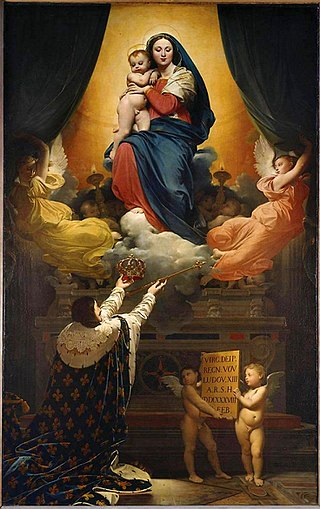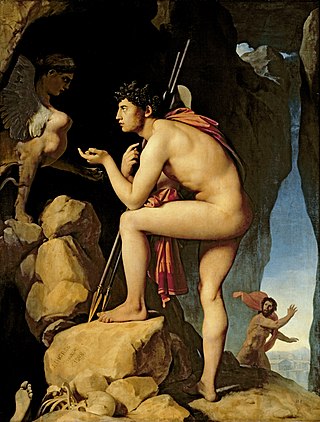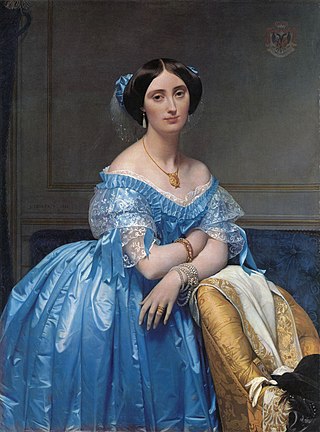
Jean-Auguste-Dominique Ingres was a French Neoclassical painter. Ingres was profoundly influenced by past artistic traditions and aspired to become the guardian of academic orthodoxy against the ascendant Romantic style. Although he considered himself a painter of history in the tradition of Nicolas Poussin and Jacques-Louis David, it is his portraits, both painted and drawn, that are recognized as his greatest legacy. His expressive distortions of form and space made him an important precursor of modern art, influencing Picasso, Matisse and other modernists.

Portrait of Baldassare Castiglione is a c. 1514–1515 oil painting attributed to the Italian High Renaissance painter Raphael. Considered one of the great portraits of the Renaissance, it has an enduring influence. It depicts Raphael's friend, the diplomat and humanist Baldassare Castiglione, who is considered a quintessential example of the High Renaissance gentleman.

Napoleon I on his Imperial Throne is an 1806 portrait of Napoleon I of France in his coronation costume, painted by the French painter Jean-Auguste-Dominique Ingres.

Madame Moitessier is a portrait of Marie-Clotilde-Inès Moitessier begun in 1844 and completed in 1856 by Jean-Auguste-Dominique Ingres. The portrait, which depicts Madame Moitessier seated, is now in the collection of the National Gallery in London, which acquired it in 1936.

Portrait of Monsieur Bertin is an 1832 oil on canvas painting by Jean-Auguste-Dominique Ingres. It depicts Louis-François Bertin (1766–1841), the French writer, art collector and director of the pro-royalist Journal des débats. Ingres completed the portrait during his first period of success; having achieved acclaim as a history painter, he accepted portrait commissions with reluctance, regarding them as a distraction from more important work. Bertin was a friend and a politically active member of the French upper-middle class. Ingres presents him as a personification of the commercially minded leaders of the liberal reign of Louis Philippe I. He is physically imposing and self-assured, but his real-life personality shines through – warm, wry and engaging to those who had earned his trust.

The Turkish Bath is an oil painting by Jean-Auguste-Dominique Ingres, initially completed between 1852 and 1859, but modified in 1862. The painting depicts a group of nude women at a pool in a harem. It has an erotic style that evokes both the Near East and earlier western styles associated with mythological subject matter. The painting expands on a number of motifs that Ingres had explored in earlier paintings, in particular The Valpinçon Bather (1808) and La Grande odalisque (1814).

Odalisque with Slave is an 1839 painting by Jean-Auguste-Dominique Ingres commissioned by Charles Marcotte. Executed in oil on canvas, it depicts a nude odalisque, a musician, and a eunuch in a harem interior. The painting is in the Fogg Art Museum in Cambridge, Massachusetts. It is a classic piece of Orientalism in French painting.

Baronne de Rothschild is an 1848 portrait by the French Neoclassical artist Jean-Auguste-Dominique Ingres. The sitter, Betty de Rothschild (1805–1886) had married her paternal uncle banker James Mayer de Rothschild and was one of the wealthiest women in Europe, and one of the foremost Parisian patrons of the arts. Her beauty and elegance were widely known and celebrated, and inspired Heinrich Heine's poem The Angel. For her portrait, which is painted in oil on canvas, Ingres sought to infuse symbols of her material wealth with the dignity, grace and beauty of Renaissance art, especially that of Raphael, while at the same time adhering to the command of line as practiced by Jan van Eyck. It is this combination which, according to art historians, places Ingres so far apart from his early modernist contemporaries.
Charles-Simon Pradier was a Swiss engraver who also worked in France and Brazil. He was recognized as one of the leading engravers of his day. He collaborated with Jean Auguste Dominique Ingres on several works.

The Martyrdom of Saint Symphorian is an 1834 painting by Jean-Auguste-Dominique Ingres. It shows the death of Saint Symphorian, the first Christian martyr in Gaul. Painted in oil on canvas and measuring 407 x 339 cm, it is now in Autun Cathedral. Although Ingres considered the painting—completed only after ten years of diligent work—one of his crowning achievements, it was criticized harshly when he exhibited it in the Paris Salon of 1834. It subsequently has been considered emblematic of Ingres' misguided ambition to excel as a history painter.

The Vow of Louis XIII is an 1824 painting by Jean-Auguste-Dominique Ingres, now in Montauban Cathedral. The oil painting shows a vow to the Virgin Mary by Louis XIII of France.

Oedipus and the Sphinx is a painting by the French Neoclassical artist Jean-Auguste-Dominique Ingres. Originally a student work painted in 1808, it was enlarged and completed in 1827. The painting depicts Oedipus explaining the riddle of the Sphinx. An oil painting on canvas, it measures 189 x 144 cm, and is in the Louvre, which acquired it in 1878.

Portrait of Madame Duvaucey is an 1807 oil on canvas painting by Jean-Auguste-Dominique Ingres. It shows Antonia Duvauçey of Nittis, the lover of Charles-Jean-Marie Alquier, then ambassador to the Holy See. Duvaucey is positioned in a flat pictorial space, gazing frontally at the viewer, dressed in lavish clothing and accessories. The portrait is the first female portrait painted during the artist's stay in Rome. Portrait of Madame Duvaucey is acclaimed for exhibiting her enigmatic charm, and as "not a portrait that gives pleasure..[but]...a portrait that gives rise to dreams".

The Portrait of Comtesse d'Haussonville is an 1845 oil-on-canvas painting by the French Neoclassical artist Jean-Auguste-Dominique Ingres.

The Princesse de Broglie is an oil-on-canvas painting by the French Neoclassical artist Jean-Auguste-Dominique Ingres. It was painted between 1851 and 1853, and shows Pauline de Broglie, who adopted the courtesy title 'Princesse'. Born Pauline de Galard de Brassac de Béarn, she married Albert de Broglie, the future 28th Prime Minister of France, in 1845. Pauline was 28 at the time of the painting's completion. She was highly intelligent and widely known for her beauty, but she suffered from profound shyness and the painting captures her melancholia. Pauline contracted tuberculosis in her early 30s and died in 1860 aged 35. Although Albert lived until 1901, he was heartbroken and did not remarry.

Self-Portrait at Seventy-Eight is an 1858 oil-on-canvas painting by the French Neoclassical artist Jean-Auguste-Dominique Ingres. It is one of the last of his many portraits, which he had always regarded as bothersome distractions from his true calling, history painting. The painting measures 24 3/8 x 20 1/8 inches and is in the Uffizi Gallery, Florence.

Portrait of Paul Lemoyne is an oil on canvas painting by the French Neoclassical artist Jean-Auguste-Dominique Ingres, completed between 1810 and 1811. It his held at the Nelson-Atkins Museum of Art, Kansas City. The model is Paul Lemoyne (1784–1883), a French sculptor, who visited Ingres during his first stay in Rome, when this portrait was executed. He is depicted as youthful, dashing, fiery, dark and handsome. Lemoyne is shown in an unguarded and informal pose, suggesting that the work completed as a gift for a friend rather than as a paid commission. The dark black and green background seems splashed on, and serves to accentuate the subject's dark facial features and black hair. Lemoyne looks disheveled, with rough hair and open shirt collars.

Self-Portrait is an oil-on-canvas painting by the French Neoclassical artist Jean-Auguste-Dominique Ingres. The painting measures 25.2 x 20.9 inches and is part of the permanent collection of the Royal Museum of Fine Arts in Antwerp. This painting is one of the last portraits by Ingres.

The Portrait of Madame Jacques-Louis Leblanc is an oil painting by the French Neoclassical artist Jean-Auguste-Dominique Ingres, painted in 1823 and displayed at the Metropolitan Museum of Art in New York.

Luigi Cherubini and the Muse of Lyric Poetry is an 1842 oil-on-canvas allegorical portrait of Luigi Cherubini by Jean-Auguste-Dominique Ingres and his then-pupil Henri Lehmann. It was bought from Ingres for 8,000 francs by Louis-Philippe I using civil list money in June 1842 and given to the musée du Luxembourg, before being moved in 1874 to the Louvre Museum, in whose collections it still resides.





















